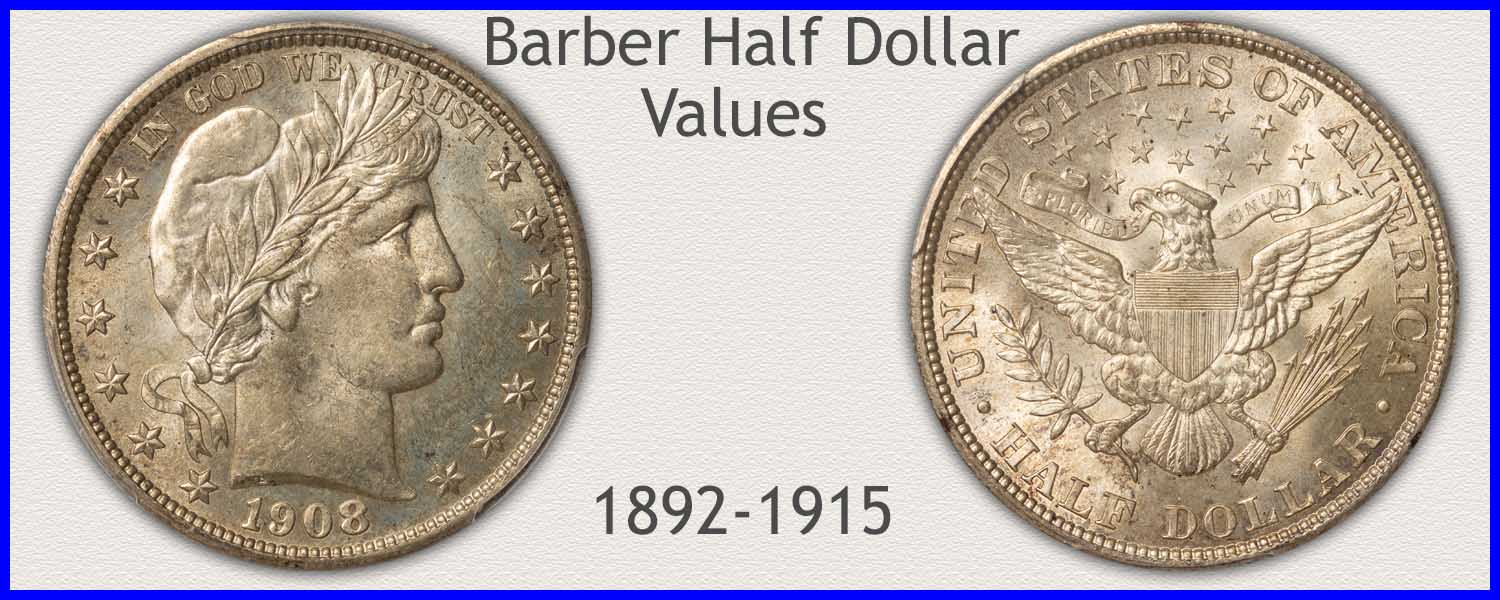Coin Values Moving with Precious Metals: Up-Dated 4/14/2025: Gold $3226 | Silver $31.88
1898 Half Dollar Value
In order to realize a narrow 1898 half dollar value, follow a step-by-step process. There are several important factors to recognize when it comes to determining how much vintage Barber halves are worth.
Mintmarks, which identify the mint that struck the coin, are of particular interest to collectors. A variety of values reflect the fact that each is recognized for varying levels of scarcity. Following is a series of images used to recognize various mintmarks.
In the section on grading, another important factor, evaluate the coin's condition and further define its listing on the chart.
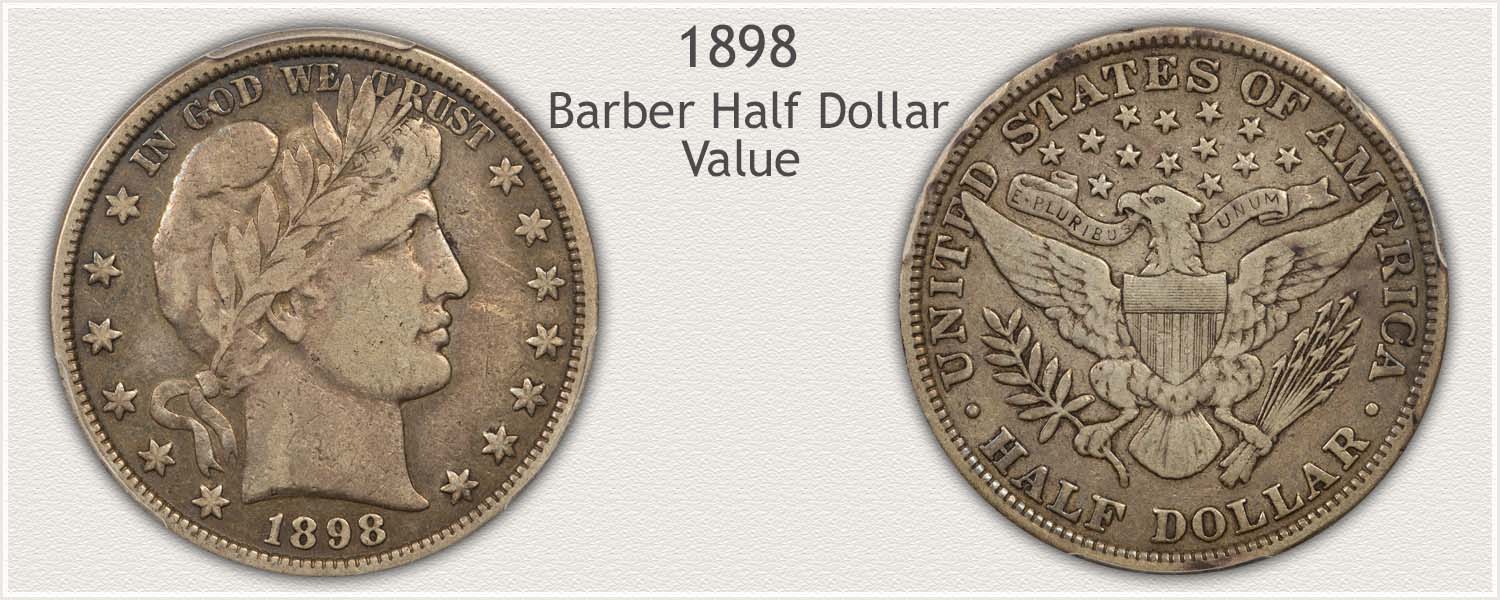
Steps Leading to Value:
- Step 1: Date and Mintmark Variety - A fully comprehensive and accurate description of these vintage Barber half dollars, includes identifying mintmarks as an important first step.
- Step 2: Grading Condition - There are clear differences in the condition of these old half dollars. By comparing to images, grading identifies the condition, and its position on the value chart is determined.
- Step 3: Special Qualities - Interest of collectors in coins of a long ago century, creates a special quality to these half dollars.
| 1898 Half Dollar Value | ||||
|---|---|---|---|---|
| Condition of Coin | ||||
| Date | Good | Fine | Extremely Fine | Mint State |
| Barber Half Dollar Values Updated | 4/14/2025 | |||
| 1898 | $18.99 | $67 | $149 | $434 |
| 1898 O | $50 | $213 | $462 | Rare |
| 1898 S | $30 | $68 | $289 | $1,190 |
Values listed on the chart are Wholesale. Use these values as a starting range. A dealer's needs and precise condition of the half dollar all narrow this range.
Step 1: | Date and Mintmarks: Important to Value Process
Branch Mints Are Leading in 1898 Half Dollar Value
1898 is the year in which demand for two scarce mint varieties show increases in value. Typically, San Francisco and New Orleans mint issues contributed the least amount to the annual total of Barber half dollars.
All mint varieties are valued separately and identified by mintmarks placed on coins struck by the various branch mints. Verify and record the accurate date and mint combination.
1898-S Barber Half Dollar
"S" Mintmark on Reverse: San Francisco Mint Struck the Coin
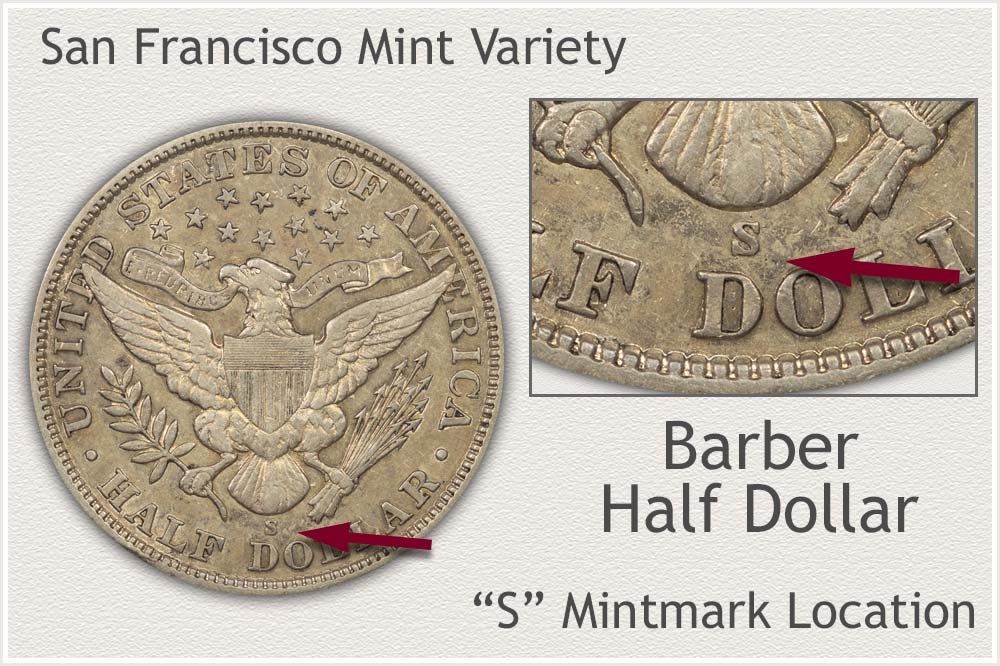
It is important to know both the date and the mint variety when describing a coin. There were an ample number of 1898 half dollars minted, but only a small percentage of them were saved and remain today. Mint records show a total of 2,358,550 were struck at the Western Mint in San Francisco and released into circulation. These are a highly valued coin today because of low remaining quantities. In all grades of condition, these is a strong premium over base silver worth. Few were saved from circulation; most are in low condition with above average quality examples scarce. A nice coin to recognize.
The large "S" mintmark on the reverse verifies that it is a San Francisco issue. Inspect the area above "HALF DOLLAR" and below the eagle to locate the "S" mintmark.
1898-O Barber Half Dollar
"O" Mintmark on Reverse: New Orleans Mint Struck the Coin
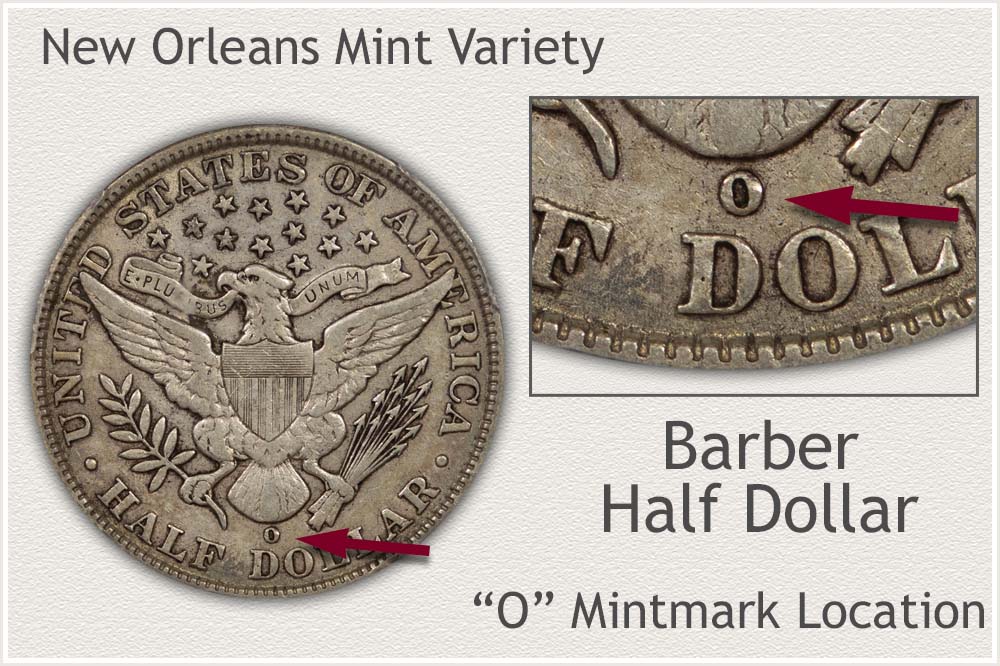
The New Orleans mint produced very few half dollars towards the end of the 1890s decade. This has led to high premiums for pieces in any state of preservation. 1898 became New Orlean's forth lowest mintage year of the Barber series half dollars. Mint records report only 874,000 half dollars were made, and collectors consider the coin scarce and desirable.
These enjoy steady demand as a notability difficult coin to find, important to complete a collection, and are worth a strong premium regardless of their condition. Step 2 focuses on grading condition, now an important consideration to value.
The large "O" mintmark on the reverse of an 1898 half dollar identifies the mint. New Orleans placed its mintmark, "O" on the reverse, located just below the eagle and above "HALF DOLLAR."
1898 Barber Half Dollar
No Mintmark on Reverse: Philadelphia Mint Struck the Coin
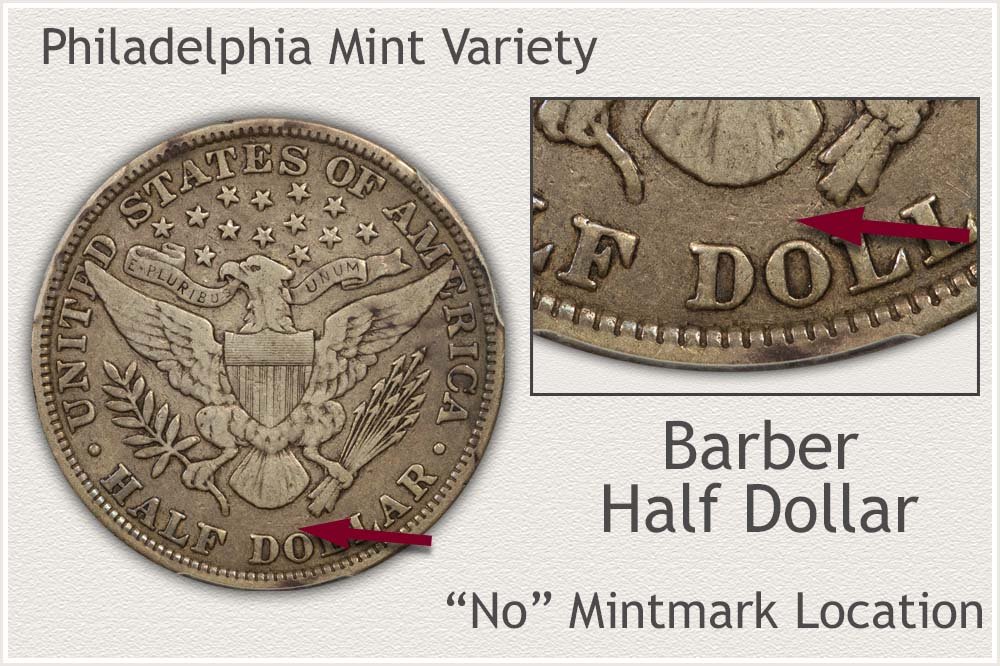
Philadelphia issue 1898 half dollars are important issues to identify accurately in all stages of preservation. Philadelphia struck and released 2.9 million of these coins into circulation. Today, they are all highly sought by collectors and are worth a growing premium due to their silver content. Grading condition in Step 2 alerts to higher quality and demand.
Philadelphia variety Barber half dollars are distinguished by the lack of a mintmark on the coin's reverse. If the space on the reverse, between the eagle and HALF DOLLAR, is empty, the coin is a Philadelphia half dollar.
Step 2: | Grading is a Close Inspection of Condition
Images are Used to Recognize Condition and Premium Half
A close inspection of 1898 half dollars is needed to judge both condition and identify a high-quality example. Many examples remaining today of these halves are in low condition. Finding key elements visible in the design features points to an above average coin.
Grading inspects the surface condition by comparing to images of the different grades to find a match.
Mint State Grade
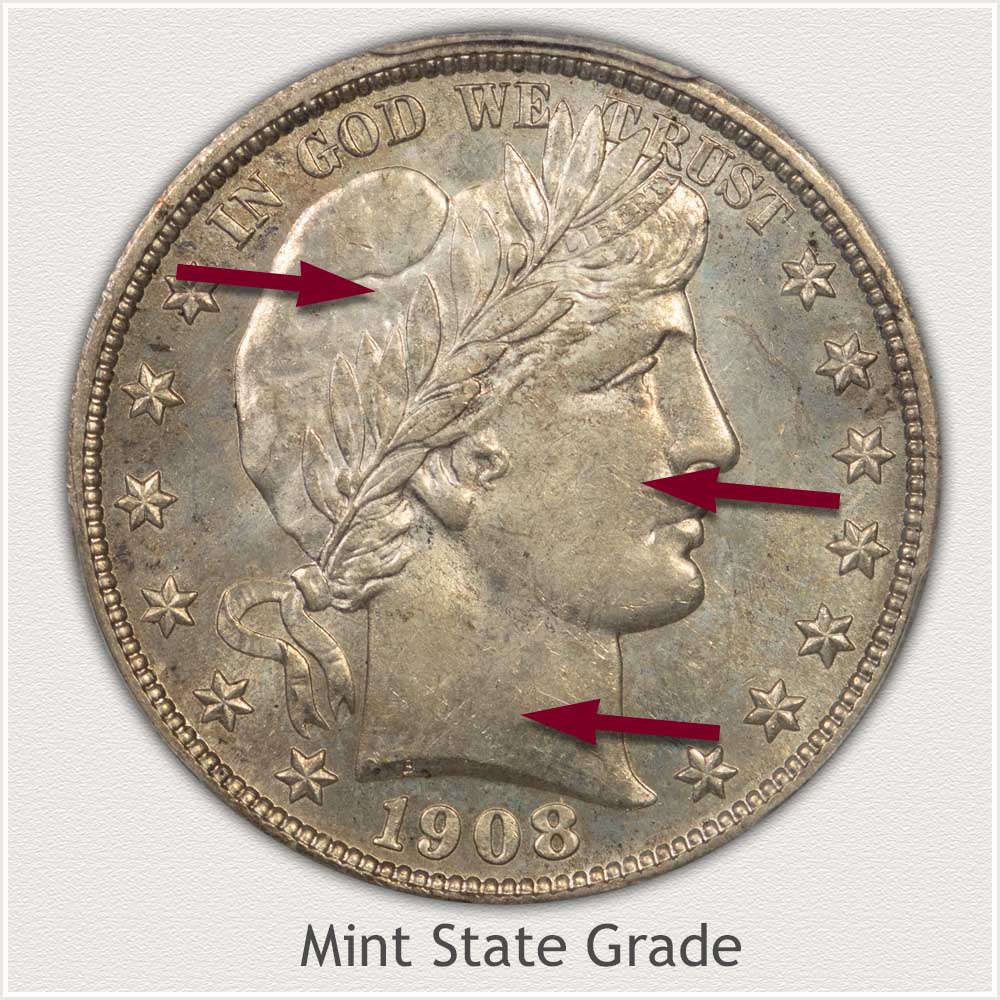
Mint State: Judging a Barber half dollar as Mint State condition is realizing a large increase in both rarity and value. Mint State is defined as a coin without wear to the surface. This is identified when inspecting a few key areas: Liberty's face, leaves of the wreath, and her cap.
When first minted, silver has a fine texture of luster that radiates as light moves across the surface. This delicate grain of luster is fragile and wears quickly. On a Barber half, open areas of Liberty's cheek remain with the covering of luster. Compare her cheek to her neck, another area prone to wear, for a similar look. Both cheek and neck on mint state coins are similar in shine and texture, as are lower relief areas, just under the chin is a good comparison.
Wear on the metal smooths the surface and changes its color from brilliance to a soft gray. Inspect the leaves of the Laurel wreath, a fine detail quick to show signs of wear. Leaves remain fully lustrous overall, with high areas and raised edges.
Continue to examine Liberty's cap and confirm all open areas remain with the texture of luster, no dulling of the metal, and similar brilliance to her cheek and neck. Slowly tilt the coin under a light to see the continuous flow of mint luster.
Extremely Fine Grade
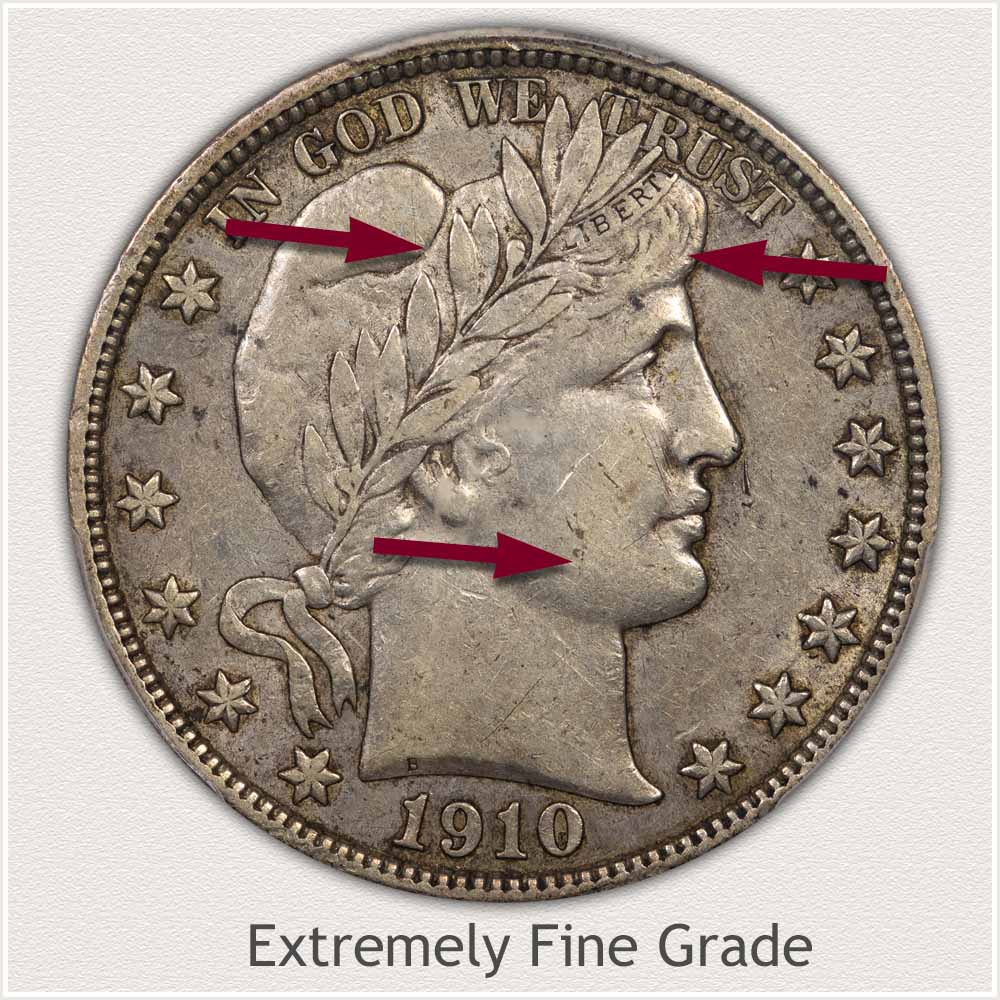
Extremely Fine: Vintage Barber half dollars in a condition showing just minor wear are highly sought by coin collectors. Extremely Fine grade is defined and characterized by light wear that appears as small flattened spots.
High relief areas such as the laurel wreath around Liberty's head and her hair are both well-defined with sharp, clear detail. There is evidence of blending of hair strands along the hair line just above her forehead. This slight wear is acceptable for the grade. Some of the hair strands' very high points are smoothed from light wear, flattening their previously rounded contours. This smoothing continues across the hair from Liberty's ear to the top of her forehead.
Additionally, the wreath's design is primarily rows of laurel leaves. Notice the raised edges with high and low contours of the leaves are all fully visible. Contours and leaf edges are only slightly smoothed, with faint flat areas. In particular, the uppermost row of leaves retains most of their original contours. Every leaf still has a distinct relief, is clearly defined, and is well separated.
This example qualifies as Extremely Fine grade due to its pleasingly toned soft gray color highlighting its defined, crisp details.
Fine Grade
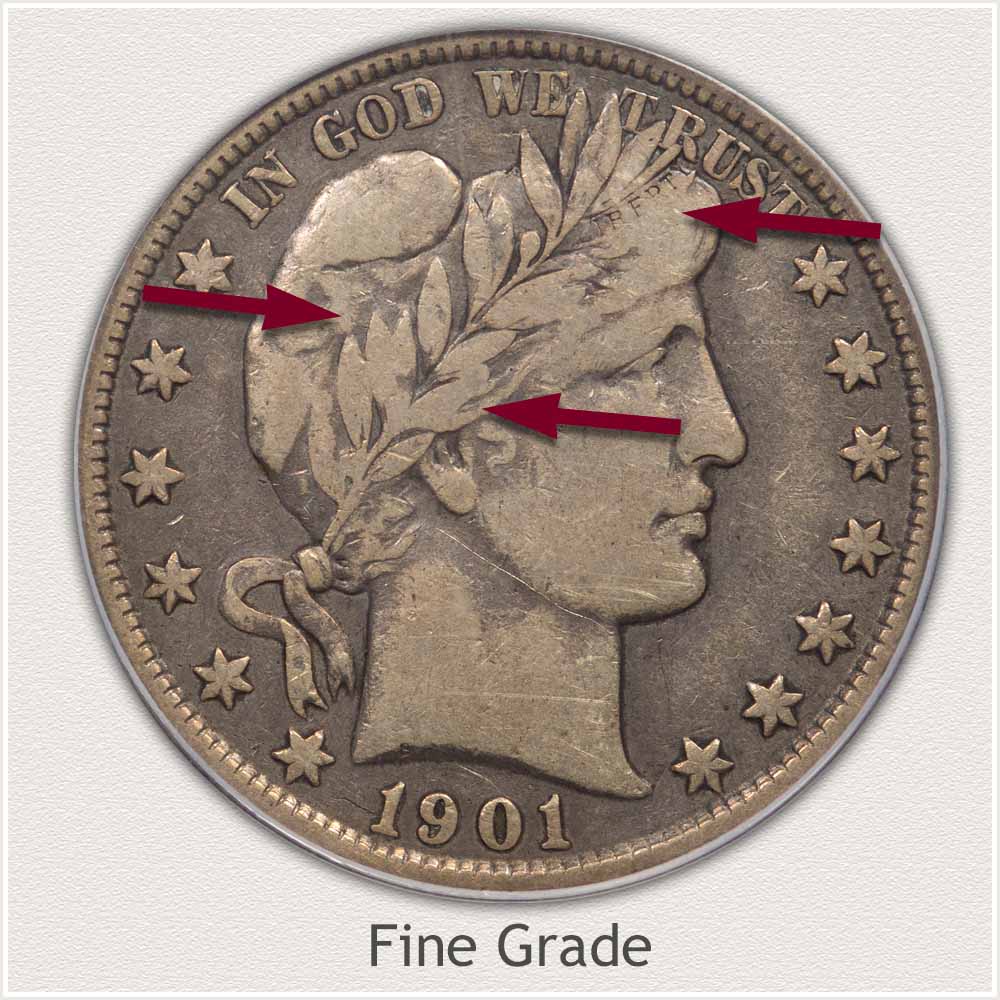
Fine Grade: Many small details visible, with some merging of design, while retaining a crisp overall appearance, helps characterize a Barber half dollar in Fine condition.
These collectible quality coins strike a nice balance between completeness of remaining small details and the amount of visible wear overall. For instance, the word "LIBERTY" is completely readable above the forehead. Nonetheless, obvious signs of wear are also present. A few of the letters are often weak, and the ribbon shows missing detail, particularly along the lower edge, where it blends with her forehead.
The laurel wreath's ample detail is a key feature to identify the Fine grade. A nicely displayed upper row of leaves is clearly outlined within Liberty's hair. However, wear has begun to merge leaf edges to the lower row. The design's remaining combination of visible and missing leaves places it in the Fine grade category.
These coins have a clearly worn appearance as well as a quality look. Remaining design is highlighted by a silvery gray color with deeper tones along the rim, creating an aesthetically pleasing overall effect.
Good Grade
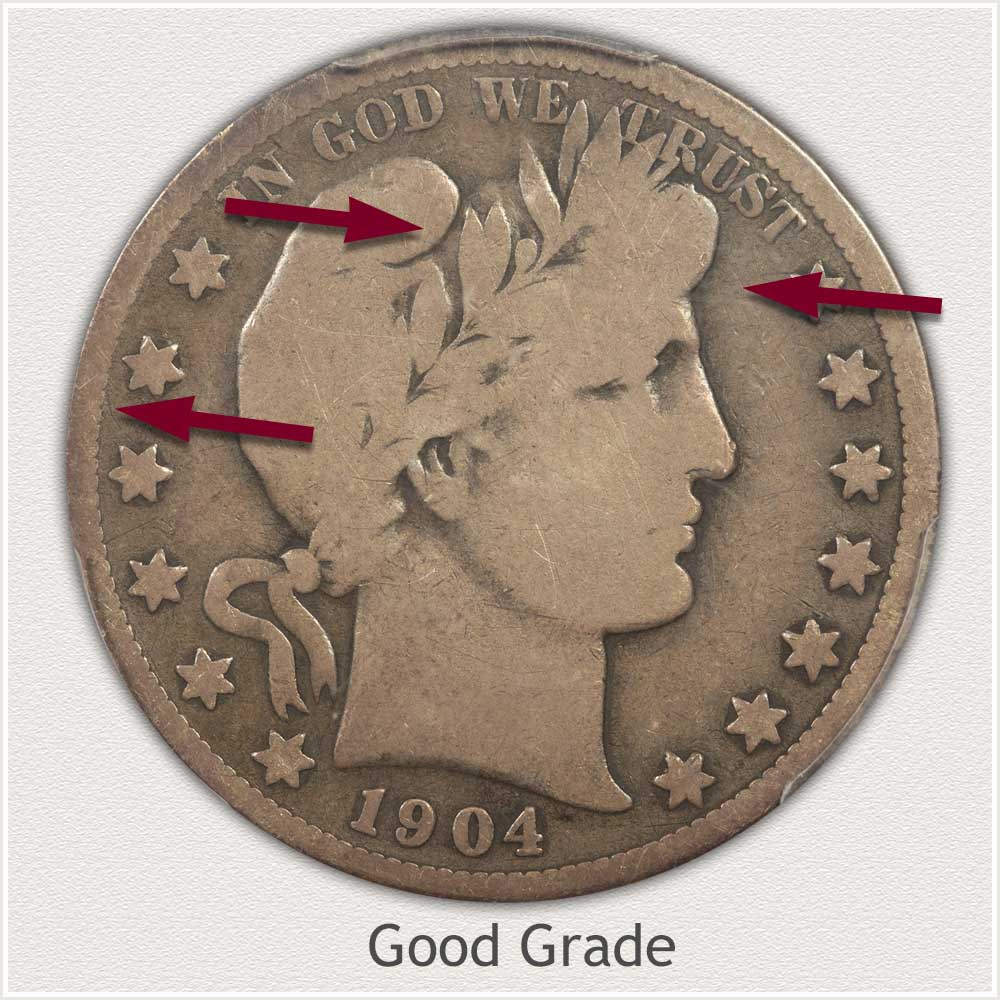
Good Grade: A "Good" grade is appropriate when the portrait is heavily worn to an outline without blending into the field. Major design elements on coins in this condition are still crisply outlined.
Liberty's portrait frequently has traces of leaves visible in her hair, especially near the top of her wreath. Her ear and eye are still visible, but the line defining her jaw is either very weak or completely missing.
A complete rim that does not have any areas that merge with the lettering of the motto or the stars is another requirement. Because each remaining feature is well raised from the field, a collectible coin has an overall impression of sharpness.
How to Video: Grading Barber Half Dollars
Within each stage of condition, a few important areas are key to confirming the grade. Additional descriptions highlighted with images help recognize the true state of preservation.
Video, Images and Descriptions | Grading Barber Half Dollars
Step 3: | Special Qualities | Nineteenth Century Allure
1898 Half Dollar Specialty Collection
Barber half dollars are a series of interest to collectors. However, one of the limiting features to new collectors is the high cost of nice coins. Any Barber half dollar in Fine grade, a condition with ample detail, is a large commitment to many.
A special quality of the 1898 halves is they are in a price range suitable to new collectors with an interest in these large silver coins. 1898 half dollars representing 19th century coinage are appealing as historically important. A large silver coin from centuries ago. Collectors of all levels of budgets appreciate the appeal of the 1898 Barber half and what it represents.
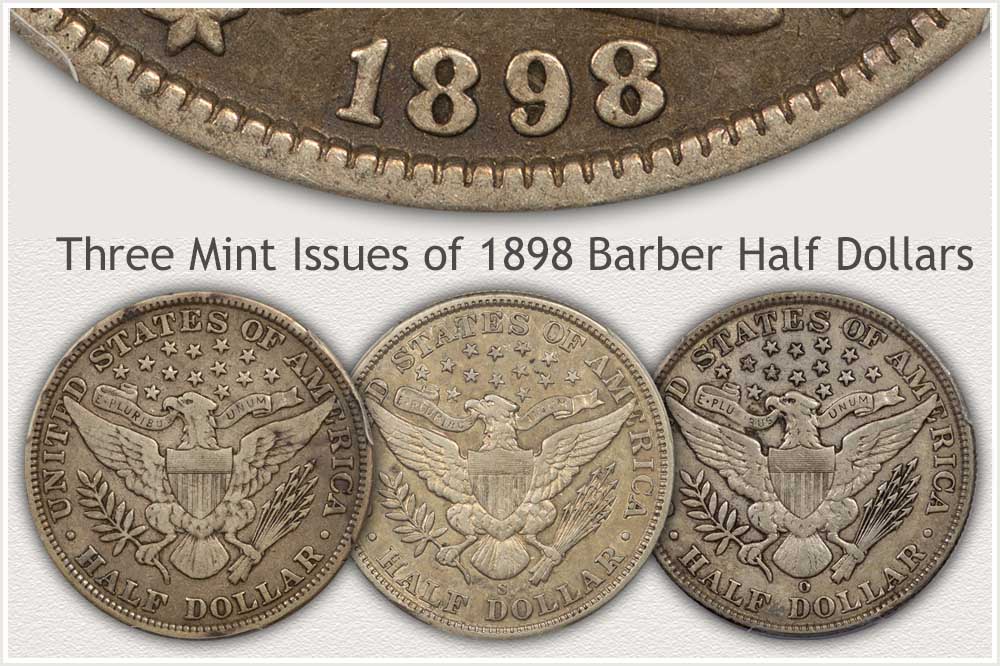 Three Coin Set of 1898 Barber Halve Dollar Mint Issues
Three Coin Set of 1898 Barber Halve Dollar Mint Issues
Philadelphia mint variety of the 1898 is the readably available half with supplies in the affordable range.
San Francisco minted 2.3 million 1898 half dollars with the "S" mintmark, and as a very old coin, appeal to many collectors. The San Francisco half is a semi-scarce, obtainable variety.
New Orleans is a favorite mint issue with collectors. Now an obsolete minting facility, these coins are often collected as a separate theme set. The 1898-O mintmark issue remains a coin new collectors can focus on to represent the popular mint variety.
Wide appeal plus affordability add to special qualities found in the 1898 Barber half dollar. Continued demand for an historically important and now very old coin is supporting strong values. A three-coin set of 1898 Philadelphia, San Francisco, and New Orleans mint variety half dollars is a worthy accomplishment.
References
U.S. Mint. 1899 U.S. Mint Annual Report
https://nnp.wustl.edu/library/book/514119
U.S. Mint. Catalogue of Coins of the United States.
https://nnp.wustl.edu/library/book/554591
Coin Values | CoinStudy Articles
Date by Date
In Depth Barber Half Dollar Values
1892 to 1915
Barber Half Dollar Value | Scarce Low Mintages
Many dates of the Barber half dollar series are scarce because of low mintages; these coins stand out on the full value chart with high premiums. Identify the important factors to narrow how much an old half dollar is worth.
With an image index and value charts listing minimum values, quickly find the value of old coins. Links to in-depth coverage of key factors to examine plus close-up grading images help complete an accurate judgment of U.S. coinage.
Selling Coins | A Defined Process
First organize your coins to accurately identify each. Placing a narrow value range on the coins prepares for the selling step. Follow the process used by collectors to find dealers suitable to contact from the dealer listings.
Coin Grading Services | Authenticate and Grade of Coins
Coins with potential values above one hundred dollars are good candidates to have reviewed by a grading service. Collectors send coins to these services to authenticate and grade premium examples, helping confirm grade. Two services, NGC and PCGS, are leaders in the coin collecting field to authenticate, grade, and encapsulate coins.
★Coin Values Discovery finds 1898 Barber Half Dollar Value and...
U.S. coin value charts plus a step-by-step method finds a narrow range to how much old coins are worth. Begin here with in-depth coverage of the important features to identify on each coin. Dates plus mint varieties are identified, judging condition with images and video; also, identifying special qualities finds the potential in a box of old coins.
